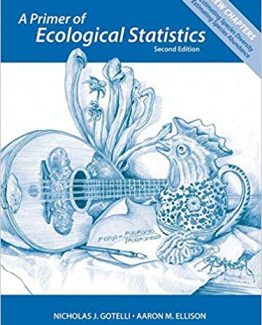Introduction to Geography 16th Edition by Mark Bjelland, ISBN-13: 978-1260364132
[PDF eBook eTextbook] – Available Instantly
- Publisher: McGraw Hill; 16th edition (February 4, 2021)
- Language: English
- ISBN-10: 1260364135
- ISBN-13: 978-1260364132
Introduction to Geography is written to clearly and concisely convey the nature of the field of geography, its intellectual challenges, and the logical interconnections of its parts. Even if students take no further work in geography, they will have come into contact with the richness and breadth of Geography and have new insights and understandings for their present and future roles as informed adults. This new edition provides students content and scope of the subfields of geography, emphasizes its unifying themes, and provides the foundation for further work in their areas of interest.
Table of Contents:
Cover
Title
Copyright
Meet the Authors
Brief Contents
Contents
Preface
Features
Connect
Chapter 1: Introduction
1.1 What Is Geography?
1.2 Evolution of the Discipline
Subfields of Geography
Why Geography Matters
1.3 Some Core Geographic Concepts
Location, Direction, and Distance
Size and Scale
Physical and Cultural Attributes
Attributes of Place Are Always Changing
Interrelations between Places
Place Similarity and Regions
1.4 Geography’s Themes and Standards
1.5 Organization of This Book
Key Words
Thinking Geographically
Chapter 2: Techniques of Geographic Analysis
2.1 Maps as the Tools of Geography
2.2 Locating Points on a Sphere
The Geographic Grid
Land Survey Systems
2.3 Map Projections
Area
Shape
Distance
Direction
2.4 Scale
2.5 Types of Maps
Topographic Maps and Terrain Representation
Thematic Maps and Data Representation
Map Misuse
2.6 Contemporary Spatial Technologies
Remote Sensing
Global Navigations Satellite Systems
Geography & Public Policy: Civilian Spy Satellites
Virtual and Interactive Maps
Geography & Public Policy: Citizenship and Mapping
2.7 Integrating Technology: Geographic Information Systems
The Geographic Database
Applications of GIS
Systems, Maps, and Models
Summary of Key Concepts
Key Words
Thinking Geographically
Chapter 3: Physical Geography: Landforms
3.1 Earth Materials
Igneous Rocks
Sedimentary Rocks
Metamorphic Rocks
3.2 Geologic Time
3.3 Movements of the Continents
3.4 Tectonic Forces
Diastrophism
Volcanism
3.5 Gradational Processes
Weathering
Mass Movement
Erosional Agents and Deposition
3.6 Landform Regions
Geography & Public Policy: Beaches on the Brink
Summary of Key Concepts
Key Words
Thinking Geographically
Chapter 4: Physical Geography: Weather and Climate
4.1 Air Temperature
Earth Inclination
Reflection and Reradiation
Lapse Rate
4.2 Air Pressure and Winds
Pressure Gradient Force
The Convection System
Land and Sea Breezes
Mountain and Valley Breezes
The Coriolis Effect
The Frictional Effect
The Global Air-Circulation Pattern
4.3 Ocean Currents
4.4 Moisture in the Atmosphere
Types of Precipitation
Storms
4.5 Climate Regions
Tropical Climates (A)
Dryland Climates (B)
Mild Midlatitude Climates (C)
Severe Midlatitude Climates (D)
Arctic Climates (E)
Highland Climates (H)
4.6 Climate Change
Long-Term Climate Change
Short-Term Climate Change
The Greenhouse Effect and Global Climate Change
Summary of Key Concepts
Key Words
Thinking Geographically
Chapter 5: Population Geography
5.1 Population Growth
5.2 Population Definitions
Birth Rates
Fertility Rates
Death Rates
Population Pyramids
Natural Increase and Doubling Times
5.3 The Demographic Transition
The Western Experience
A Divided World, a Converging World
Geography & Public Policy: International Population Policies
5.4 The Demographic Equation
Population Relocation
Immigration Impacts
5.5 World Population Distribution
Population Density
Overpopulation?
5.6 Population Data and Projections
Population Data
Population Projections
5.7 Population Controls
5.8 Population Prospects
Population Implosion?
Momentum
Aging
Summary of Key Concepts
Key Words
Thinking Geographically
Chapter 6: Cultural Geography
6.1 Components of Culture
6.2 Subsystems of Culture
The Technological Subsystem
The Sociological Subsystem
The Ideological Subsystem
6.3 Interaction of People and Environment
Environments as Controls
Human Impacts
6.4 Culture Change
Innovation
Diffusion
Acculturation
6.5 Cultural Diversity
6.6 Language
Language Spread and Change
Standard and Variant Languages
Language and Culture
6.7 Religion
Classification and Distribution of Religions
Geography & Public Policy: Changing Place Names
The Principal Religions
6.8 Ethnicity
6.9 Gender and Culture
6.10 Other Aspects of Diversity
Summary of Key Concepts
Key Words
Thinking Geographically
Chapter 7: Human Interaction
7.1 The Definition of Human Interaction
7.2 Distance and Human Interaction
7.3 Barriers to Interaction
7.4 Human Interaction and Innovation
7.5 Individual Activity Space
Stage in Life
Mobility
Opportunities
7.6 Diffusion and Innovation
Medical Geography and Diffusion: COVID-19
Contagious Diffusion
Hierarchical Diffusion
7.7 Human Interaction and Technology
Automobiles
Telecommunications
7.8 Migration
Types of Migration
Incentives to Migrate
Geography & Public Policy: Broken Borders
Barriers to Migration
Patterns of Migration
7.9 Globalization, Integration, and Interaction
Economic Integration
Political Integration
Cultural Integration
Summary of Key Concepts
Key Words
Thinking Geographically
Chapter 8: Political Geography
8.1 National Political Systems
Evolution of the Modern State
Nations and Nation-States
Boundaries: The Limits of the State
Centripetal Forces: Promoting State Cohesion
Centrifugal Forces: Challenges to State Authority
8.2 Cooperation Among States
Supranationalism
The United Nations and Its Agencies
Regional Alliances
8.3 Local and Regional Political Organization
Forms of State Organization
Special Types of Regions
Electoral Systems
The Districting Problem
The Fragmentation of Political Power
Summary of Key Concepts
Key Words
Thinking Geographically
Chapter 9: Economic Geography: Agriculture and Primary Activities
9.1 The Classification of Economic Activity and Economies
Categories of Activity
Types of Economic Systems
Stages of Development
9.2 Primary Activities: Agriculture
Subsistence Agriculture
Expanding Crop Production
Commercial Agriculture
9.3 Other Primary Activities
Fishing
Forestry
Mining and Quarrying
9.4 Trade in Primary Products
Geography & Public Policy: Public Land, Private Profit
Summary of Key Concepts
Key Words
Thinking Geographically
Chapter 10: Economic Geography: Manufacturing and Services
10.1 World Manufacturing Patterns and Trends
10.2 Industrial Location Theory
Weber’s Least-Cost Industrial Location Model
Other Locational Considerations
10.3 Innovation in Manufacturing Processes and Products
Flexible Production Processes
Geography & Public Policy: Incentives or Bribery?
High Technology Products
Factors in High Technology
10.4 Outsourcing and Transnational Corporations
10.5 Service Activities
Types of Service Activities
Consumer Services
Business Services
Summary of Key Concepts
Key Words
Thinking Geographically
Chapter 11: An Urban World
11.1 An Urbanizing World
11.2 Origins and Evolution of Cities
Defining the City Today
The Location of Urban Settlements
11.3 Functions of Cities
Cities as Central Places
Cities as Centers of Production and Services
Cities as Centers of Administration and Institutions
11.4 Systems of Cities
The Urban Hierarchy
Rank-Size Relationships
World Cities
11.5 Inside the City
Classic Patterns of Land Use
Institutional Controls
Social Areas of Cities
Changes in Urban Form
Geography & Public Policy: The Homeless
11.6 Global Urban Diversity
Western European Cities
Eastern European Cities
Rapidly Growing Cities in the Developing World
Summary of Key Concepts
Key Words
Thinking Geographically
Chapter 12: The Geography of Natural Resources
12.1 Resource Terminology
Renewable Resources
Nonrenewable Resources
Resource Reserves
12.2 Energy Resources and Industrialization
12.3 Nonrenewable Energy Resources
Crude Oil
Coal
Natural Gas
Geography & Public Policy: Fuel-Efficient and Electric Vehicles
Oil Shale and Oil Sands
Nuclear Energy
12.4 Renewable Energy Resources
Biomass Fuels
Hydropower
Solar Energy
Geography & Public Policy: Dammed Trouble
Other Renewable Energy Resources
12.5 Nonfuel Mineral Resources
The Distribution of Nonfuel Minerals
Copper: A Case Study
12.6 Land Resources
Soils
Wetlands
Forest Resources
12.7 Resource Management
Summary of Key Concepts
Key Words
Thinking Geographically
Chapter 13: Human Impact on the Environment
13.1 Ecosystems
13.2 Impacts on Water
Availability of Water
Modification of Streams
Water Quality
Agricultural Sources of Water Pollution
Other Sources of Water Pollution
Controlling Water Pollution
13.3 Impacts on Air
Air Pollutants
Factors Affecting Air Pollution
Acid Rain
Photochemical Smog
Depletion of the Ozone Layer
Controlling Air Pollution
13.4 Impacts on Landforms
Excavation
Dumping
Subsidence
13.5 Impacts on Plants and Animals
Habitat Loss or Alteration
Hunting and Commercial Exploitation
Introduction of Exotic Species
Bioaccumulation of Toxins
Preserving Biodiversity
13.6 Waste Management
Municipal Waste
Hazardous and Radioactive Wastes
Geography & Public Policy: Yucca Mountain
13.7 Environmental Justice
Summary of Key Concepts
Key Words
Thinking Geographically
Appendices
Appendix 1: Map Projections
Appendix 2: Climate, Soils, and Vegetation
Appendix 3: 2019 World Population Data
Glossary
Index
Mark Bjelland is professor of geography at Calvin University
David H. Kaplan is a professor of geography at Kent State University. He received his Ph.D. from the University of Wisconsin at Madison and his B.A. from The Johns Hopkins University. Dr. Kaplan has published over 40 peer-reviewed articles and chapters, and he has seven books published: Segregation in Cities, Nested Identities, Boundaries and Place, Urban Geography, Landscapes of the Ethnic Economy, Perthes World Atlas, and the four-volume Nations and Nationalism: A Global Historical Overview. His research interests include nationalism, borderlands, ethnic and racial segregation, urban and regional development, housing and finance, and transportation. In his free time, he enjoys spending time with his family, cooking, bicycling, skiing, and gaining a deep appreciation of different places.
Jon C. Malinowski received his B.S. in foreign service from the Edmund A. Walsh School of Foreign Service at Georgetown University and earned his M.A. and Ph.D. in geography from the University of North Carolina at Chapel Hill. He has been a member of the geography faculty at the United States Military Academy at West Point since 1995. In addition to scholarly articles, he is the co-author of several books, including geography texts and trade books on summer camp and West Point’s changing landscape. His research interests have focused on spatial cognition, children’s geographies, and cultural geography and he has taught courses on Asia, North America, the Middle East and Africa, world regional geography, human geography, behavioral geography, economic geography, and the historical geography of the Hudson Valley. In addition to teaching and research, Dr. Malinowski has held administrative positions in the Environmental Perception and Behavioral Geography Specialty Group of the Association of American Geographers and in the Geography Program at the Academy. He also serves as a member of the Board of Directors for YMCA Camp Belknap in Tuftonboro, New Hampshire.
What makes us different?
• Instant Download
• Always Competitive Pricing
• 100% Privacy
• FREE Sample Available
• 24-7 LIVE Customer Support






Reviews
There are no reviews yet.